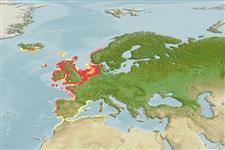Common names from other countries
Environment: milieu / climate zone / depth range / distribution range
Ecología
; rango de profundidad 0 - 60 m (Ref. 106944). Subtropical, preferred 10°C (Ref. 107945); 65°N - 32°N, 24°W - 12°E
Eastern Atlantic and the Mediterranean: From southern Iceland to North Sea, Morocco and Madeira to the Mediterranean.
Length at first maturity / Tamaño / Peso / Age
Maturity: Lm ? range ? - ? cm Max length : 5.0 cm SHL macho / no sexado; (Ref. 7882); edad máxima reportada: 13 años (Ref. 106244)
Depth based on occurrence (Ref. 2758, p. 805); to be replaced with better reference. Minimum depth from Ref. 2703. Species' maximum length from the Belgian part of the North Sea (Ref. 7882). Found along the coasts and further out into the open sea, mainly on top of sea banks. Shallowly burrows in coarse-grained sediment. A suspension feeder (Ref. 7882).
Life cycle and mating behavior
Madurez | Reproducción | Puesta | Huevos | Fecundidad | Larva
Members of the class Bivalvia are mostly gonochoric, some are protandric hermaphrodites. Life cycle: Embryos develop into free-swimming trocophore larvae, succeeded by the bivalve veliger, resembling a miniature clam.
Gaspar, M.B., M.N. Santos and P. Vasconcelos. 2001. (Ref. 2758)
IUCN Red List Status (Ref. 130435)
CITES status (Ref. 108899)
Not Evaluated
Not Evaluated
Human uses
Pesquerías: comercial
FAO - pesquerías: landings | FishSource | Sea Around Us
Herramientas
Fuentes de Internet
Estimates based on models
Preferred temperature
(Ref.
115969): 8.6 - 12.5, mean 10.4 (based on 344 cells).
Resiliencia
Alto, población duplicada en un tiempo mínimo inferior a 15 meses (K=0.23-0.43; tm=1; tmax=13).
Vulnerability
Low vulnerability (10 of 100).
